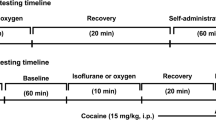Abstract
Purpose
Blockade of 5-hydroxytryptamine (5-HT)2A receptors reportedly mediates or modulates the ability of isoflurane to produce immobility during noxious stimulation and would thereby influence MAC (the minimum alveolar concentration required to suppress movement in response to noxious stimulation in 50% of subjects). However, no data are yet available regarding the role of this receptor in the immobilizing action of sevoflurane. In this study, we examined how prior intraperitoneal administration of either the 5-HT2A receptor antagonist altanserin or the 5-HT2C/2B receptor antagonist SB 206553 might affect sevoflurane MAC in rats.
Methods
Three groups of six male Wistar rats weighing 250–350 g each received one of the following drugs dissolved in dimethyl sulfoxide intraperitoneally 30 min before MAC testing: (1) altanserin 10 mg/kg; (2) SB 206553 10 mg/kg; (3) no drug (vehicle control). MAC was defined as the average of the concentrations that just prevented or just permitted movement in response to clamping the tail for 1 min.
Results
The rank order of MAC values obtained after intraperitoneal drug pretreatment and sevoflurane exposure was altanserin < SB 206553 < vehicle control.
Conclusion
Considering the low levels of 5-HT2B receptors within the CNS, this result suggests that 5-HT2A and the 5-HT2C receptors are present within the neural circuitry influencing sevoflurane MAC. Blockade of 5-HT2A and/or 5-HT2C receptors may modulate the immobility produced by sevoflurane during noxious stimulation.

Similar content being viewed by others
References
Franks NP, Lieb WR. Molecular and cellular mechanism of general aneaesthesia. Nature (Lond). 1994;367:607–14.
Minami K, Minami M, Harris RA. Inhibition of 5-hydroxytryptamine type 2A receptor-induced currents by a-alcohols and anesthetics. J Pharmacol Exp Ther. 1997;281:1136–43.
Zhang Y, Laster MJ, Eger EI II, Stabernack CR, Sooner JM. Blockade of 5-HT2A receptors may mediate or modulate part of the immobility produced by inhaled anesthetics. Anesth Analg. 2003;97:475–9.
Sathi ZS, Anisuzzaman ASM, Morishima S, Suzuki F, Tanaka T, Yoshiki H, Muramatsu I. Different affinities of native α1B-adrenoceptors for ketanserin between intact tissue segments and membrane preparations. Eur J Pharmacol. 2008;584:222–8.
Wouters W, Dun JW, Leysen JE, Laduron PM. Photoaffinity probe for serotonin and histamine receptors Synthesis and characterization of two azide analogues of ketanserin. J Biol Chem. 1985;260:8423–9.
Herth MH, Kramer V, Piel M, Palner M, Riss PJ, Knudsen GM, Rösch F. Synthesis and in vitro affinities of various MDL 100907 derivatives as potential 18F-radioligands for 5-HT2A receptor imaging with PET. Bioorg Med Chem. 2009;17:2989–3002.
Kennett GA, Wood MD, Bright F, Cilia J, Piper DC, Gager T, Thomas D, Baxter GS, Forbes IT, Ham P, Blackburn TP. In vitro and in vivo profile of SB 206553, a potent 5-HT2C/5-HT2B receptor antagonist with anxiolytic-like properties. Br J Pharmacol. 1996;117:427–34.
Vivien B, Langeron O, Coriat P, Riou B. Minimum alveolar anesthetic concentration of volatile anesthetics in normal and cardiomyopathic hamsters. Anesth Analg. 1999;88:489–93.
Dringenberg HC. Serotonergic receptor antagonists alter responses to general anaesthetics in rats. Br J Anaesth. 2000;85:904–6.
Kennett GA, Pittaway K, Blackburn TP. Evidence that 5-HT2C receptor antagonists are anxiolytic in the rat Geller–Seifter model of anxiety. Psychopharmacology. 1994;114:90–6.
McCreary AC, Cunningham KA. Effects of the 5-HT2C/2B antagonist SB 206553 on hyperactivity induced by cocaine. Neuropsychopharmacology 1999; 20: 556-564
Nakata Y, Goto T, Ishiguro Y, Terui K, Niimi Y, Morita S. Anesthetic doses of sevoflurane to block cardiovascular responses to incision when administered with xenon or nitrous oxide. Anesthesiology. 1999;91:369–73.
Bonhaus DW, Bach C, DeSouza A, Salazar FH, Matsuoka BD, Zuppan P, Chan HW, Eglen RM. The pharmacology and distribution of human 5-hydroxytryptamine2B (5-HT2B) receptor gene products: comparison with 5-HT2A and 5-HT2C receptors. Br J Pharmacol. 1995;115:622–8.
Pompeiano M, Palacios JM, Mengod G. Distribution of serotonin 5-HT2 receptor family mRNAs: comparisons between 5-HT2A and 5-HT2C receptors. Mol Brain Res. 1994;23:163–78.
Duxon MS, Flanigan TP, Reavley AC, Baxter GS, Blackburn TP, Fone KCF. Evidence for expression of the 5-hydroxytryptamine-2B receptor protein in the rat central nervous system. Neuroscience. 1997;76:323–9.
Zao ZQ, Chiechio S, Sun YG, Zhang KH, Zhao CS, Scott M, Johnson RL, Deneris ES, Renner KJ, Gereau RW IV, Chen ZF. Mice lacking central serotonergic neurons show enhanced inflammatory pain and an impaired analgesic response to antidepressant drugs. J Neurosci 2007;27:6045–6053.
Kupers R, Frokjaer VG, Naert A, Christensen R, Budtz-Joergensen E, Kehlet H, Knudsen GM. A PET [18F]altanserin study of 5-HT2A receptor binding in the human brain and responses to pain heat stimulation. NeuroImage. 2009;44:1001–7.
Michiels M, Monbaliu J, Meudermans W, Hendriks R, Geerts R, Woestenborghs R, Heykants J. Pharmacokinetics and tissue distribution of ketanserin in rat, rabbit, and dog. Arzneimittelforschung. 1988;38:775–84.
Kashimoto S, Furuya A, Nonaka A, Oguchi T, Koshimizu M, Kumazawa T. The minimum alveolar concentration of sevoflurane in rats. Eur J Anaesthesiol. 1997;14:359–61.
Alhaider AA. Antinociceptive effect of ketanserin in mice: involvement of supraspinal 5-HT2 receptors in nociceptive transmission. Brain Res. 1991;543:335–40.
Chojnacka-Wójcik E, Kłodzińska A, Dereń-Wesołek A. Involvement of 5-HT2C receptors in the m-CPP-induced antinociception in mice. Pol J Pharmacol. 1994;46:423–8.
Mukaida K, Shichino T, Koyanagi S, Himukashi S, Fukuda K. Activity of the serotonergic system. Anesth Analg. 2007;104:836–9.
Acknowledgments
This work was supported in part by Foundation for Promotion of Cancer Research in Japan.
Author information
Authors and Affiliations
Corresponding author
About this article
Cite this article
Nagatani, H., Oshima, T., Urano, A. et al. Blockade of 5-HT2A and/or 5-HT2C receptors modulates sevoflurane-induced immobility. J Anesth 25, 225–228 (2011). https://doi.org/10.1007/s00540-011-1103-x
Received:
Accepted:
Published:
Issue Date:
DOI: https://doi.org/10.1007/s00540-011-1103-x




